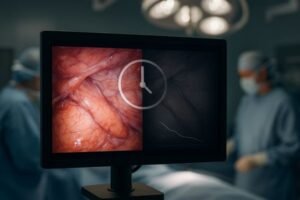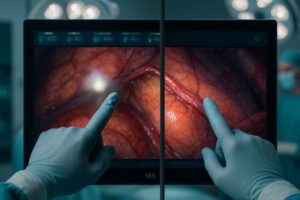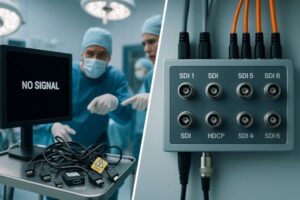A blurry image during ENT surgery can obscure a tiny nerve or blood vessel. This lack of clarity introduces risk and uncertainty, but choosing the right display resolution ensures you can see every delicate structure.
ENT procedures require a resolution that matches the complexity of the task. Full HD is sufficient for many routine examinations and surgeries. However, 4K is increasingly preferred for complex procedures like skull base or laryngeal microsurgery due to its superior detail.
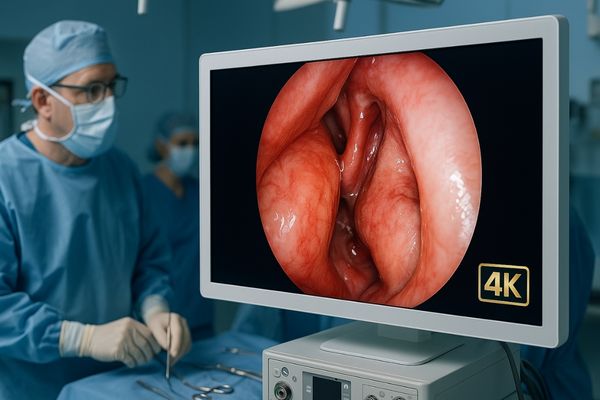
Throughout my work with surgical imaging systems, I have seen firsthand how critical image clarity1 is in otolaryngology. The anatomical regions involved are some of the most compact and intricate in the human body. A surgeon’s ability to distinguish between different tissue types is not a luxury; it is the foundation of a successful procedure. The debate between Full HD and 4K resolution2 is therefore not just about technology. It is about matching the right tool to the right job to achieve the best possible patient outcome. This article will explore the specific visual demands of ENT surgery3 and explain when each resolution is most appropriate.
Why is high resolution crucial for visualizing fine structures in ENT surgeries?
Distinguishing healthy tissue from diseased tissue is difficult on a standard screen. A misjudgment can lead to incomplete tumor removal or damage to critical structures, but high resolution reveals the details needed for confident decisions.
High resolution is crucial because it allows surgeons to clearly differentiate between fine structures like nerves, blood vessels, and mucosal tissue. This level of detail is essential for precise dissection, minimizing patient risk, and preserving healthy anatomical function during surgery.
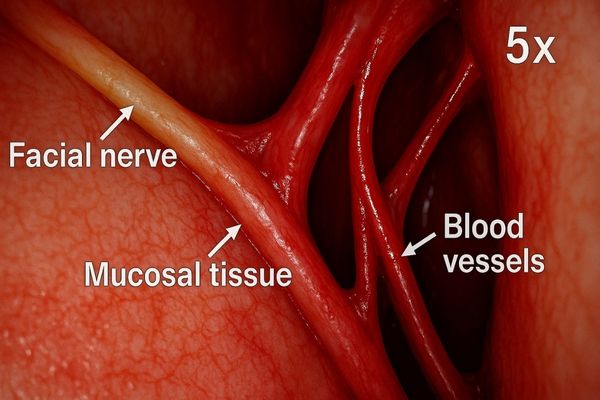
Ear, nose, and throat surgery4 takes place in confined spaces filled with critical anatomy. Structures like the facial nerve, the recurrent laryngeal nerve controlling the vocal cords, and tiny blood vessels are often fractions of a millimeter in size. A lower-resolution display can make these fine details appear blurred or indistinct, forcing the surgeon to make interpretations based on an incomplete picture. High resolution solves this problem by increasing pixel density. More pixels in the same amount of space create a sharper, more detailed image. A tiny nerve that might look like a blurry line on a standard display becomes a crisp, well-defined structure on a high-resolution screen. This clarity removes ambiguity. It allows the surgeon to see the precise boundaries between a tumor and the surrounding healthy tissue, enabling a more complete and accurate resection. Even a quality Full HD monitor5 like our MS220S is designed to render these details with exceptional clarity for many standard endoscopic tasks.
Is Full HD sufficient for routine ENT procedures?
You need a reliable monitor for your operating room, but budget constraints are a real concern. Overspending on 4K technology can strain hospital finances, especially if it provides no clear benefit for everyday procedures.
Yes, a high-quality Full HD (1920×1080) monitor is sufficient for many routine ENT procedures. It provides the necessary clarity for tasks like tonsillectomies, septoplasties, and basic endoscopic sinus surgery, offering a practical balance between performance and cost.
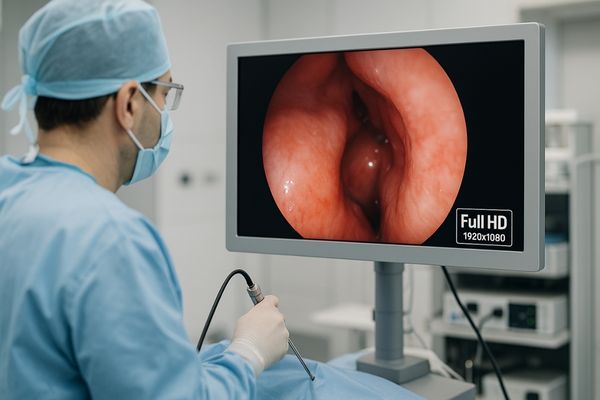
For a significant number of common ENT procedures, Full HD resolution6 provides more than enough visual information for a surgeon to operate safely and effectively. In surgeries such as a standard tonsillectomy or a septoplasty, the main objective is to have a clear, lag-free view of relatively large anatomical structures and surgical instruments. A premium Full HD monitor delivers on this requirement perfectly. It is important to remember that image quality7 is about more than just pixel count. A monitor with excellent color accuracy, high brightness, and minimal latency can provide a superior image to a low-cost 4K screen with poor processing. For many hospitals and clinics, investing in high-quality FHD displays8 like our MS270P is a very practical decision. It allows them to equip multiple operating rooms with capable, reliable technology without allocating a disproportionate amount of their budget to the highest-end specifications. This approach ensures a high standard of care across the institution in a financially responsible way.
Resolution Suitability for Common ENT Tasks
| Procedure Type | Recommended Resolution | Justification |
|---|---|---|
| Basic Nasal Endoscopy | Full HD | Sufficient for visualizing nasal passages and turbinates. |
| Tonsillectomy/Adenoidectomy | Full HD | Clear view of larger structures and bleeding is adequate. |
| Septoplasty | Full HD | Provides necessary clarity for correcting the nasal septum. |
| Advanced Sinus Surgery | 4K Preferred | Better detail for identifying subtle landmarks and disease. |
When do surgeons prefer 4K over HD in ENT applications?
A complex tumor is located near a critical nerve. Standard resolution makes it difficult to see the exact margins, which increases the risk of an incomplete resection or accidental damage.
Surgeons prefer 4K for complex procedures like endoscopic skull base surgery, cochlear implants, or delicate laryngeal microsurgery. The four times the pixel count of FHD allows for superior digital zoom without losing clarity, which is crucial for intricate dissections.
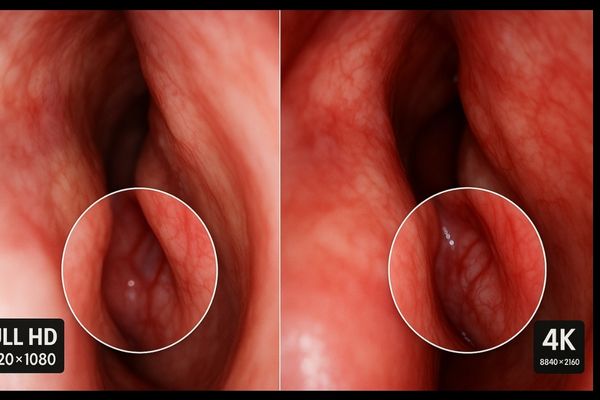
The preference for 4K resolution1 emerges when a procedure demands microscopic precision2. In complex surgeries like those at the skull base, surgeons navigate a dense area of critical nerves and blood vessels. In laryngeal surgery, the vocal cords are extremely delicate, and millimeters can define the difference between preserving a patient’s voice and causing permanent damage. In these scenarios, 4K is not a luxury; it is a vital tool. The primary advantage of 4K is its ability to handle magnification. With four times the pixels of Full HD, a surgeon can use the digital zoom to enlarge a specific part of the surgical field without the image becoming pixelated or blurry. This means they can see the fine texture of tissue and the precise location of microvasculature in great detail. This capability allows for more precise movements and a smoother workflow, as the surgeon does not need to constantly reposition the endoscope. Monitors like our MS275P 4K surgical monitor are built to deliver this enhanced detail, giving surgeons greater confidence during the most challenging cases.
How does higher resolution affect surgical precision and outcomes?
Long hours staring at a monitor screen can cause eye strain and fatigue. This mental and physical drain can slow down a surgeon and increase the likelihood of error during a procedure.
Higher resolution directly improves surgical precision by providing a clearer, more detailed view of the surgical field. This enhanced visualization can lead to better outcomes by enabling more accurate dissections, reducing procedural time, and lowering the risk of complications.
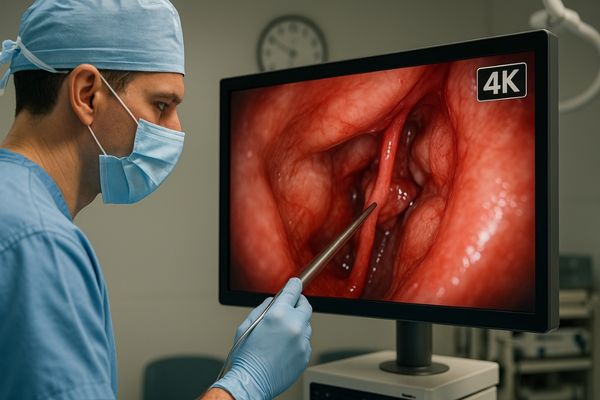
The link between display resolution9 and surgical outcome is direct. A sharper, more detailed image allows a surgeon to operate with greater precision. For example, when removing a tumor, a 4K display10 can help a surgeon more clearly identify the margin between cancerous and healthy tissue. This leads to a more complete resection while minimizing the removal of healthy tissue, which is a better outcome for the patient. Higher resolution also has a significant ergonomic benefit. The human brain has to work harder to interpret a blurry or pixelated image. Over the course of a long surgery, this can lead to significant eye strain and cognitive fatigue. A crisp, clear image is more comfortable to view, which reduces this fatigue and helps the surgeon maintain focus and concentration for longer periods. This sustained focus can reduce the rate of error and improve overall performance. A display like the MS321PC contributes to better outcomes by making the visual information easier to see and interpret, supporting the surgeon both clinically and ergonomically.
Impact of Resolution on Surgical Performance
| Impact Area | Full HD (1080p) | 4K Ultra HD (2160p) |
|---|---|---|
| Anatomical Detail | Good | Excellent (clearer microstructures) |
| Digital Zoom | Limited (pixelation occurs) | Superior (maintains clarity) |
| Surgeon Fatigue | Moderate (more eye strain) | Lower (crisper, more natural image) |
| Procedural Suitability | Routine procedures | Complex, microsurgical procedures |
How does Reshin address resolution requirements for ENT procedures in its surgical monitors?
Every hospital and surgical center has a unique mix of procedures and budget constraints. A one-size-fits-all monitor solution would force you to either overpay for unneeded technology or compromise on quality.
Reshin addresses ENT resolution needs by offering a comprehensive portfolio of both Full HD and 4K surgical monitors. This allows hospitals to select the ideal display based on their specific procedural demands, existing camera systems, and budget.
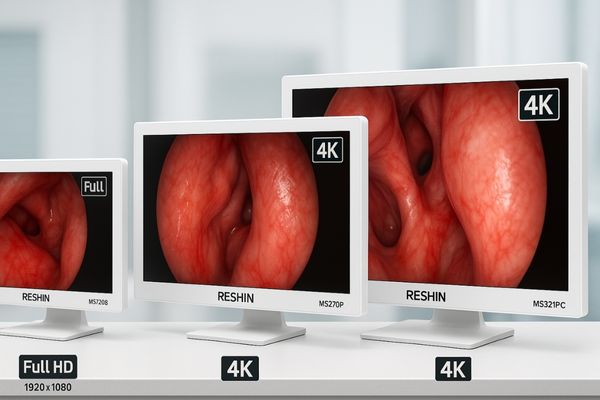
Our philosophy is to provide medical professionals with the right tool for the job. We understand that the resolution needs for a simple diagnostic endoscopy are very different from those for a complex oncological surgery. That is why we have developed a complete range of surgical monitors11 to meet the diverse requirements of ENT departments. Our Full HD monitors12 are engineered to deliver exceptional performance for routine procedures. They provide bright, color-accurate images with the low latency required for any endoscopic surgery. For institutions focused on advanced and minimally invasive techniques, our 4K monitors13, such as the MS321PB, unlock the full potential of modern 4K camera systems. These displays offer the stunning detail and clarity needed for the most demanding surgical applications. This tiered approach ensures that any facility, from a small clinic to a large teaching hospital, can find a Reshin monitor that fits its clinical needs and financial framework. Every monitor we build, regardless of its resolution, is held to the same high standards of medical-grade quality, reliability, and safety.
Conclusion
ENT procedures require resolutions matched to their complexity. Full HD is effective for routine work, while 4K is vital for complex surgery. Making the right choice enhances surgical precision and patient outcomes. To find the ideal display resolution for your ENT procedures, contact Reshin at martin@reshinmonitors.com.
- Understanding the significance of image clarity can enhance surgical outcomes and patient safety in otolaryngology. ↩ ↩
- Exploring the differences can help you choose the best imaging technology for surgical procedures. ↩ ↩
- Learning about these demands can improve surgical techniques and patient care in otolaryngology. ↩
- Discover how advancements in technology are transforming surgical practices and enhancing patient safety. ↩
- This link will help you understand the role of Full HD monitors in improving visualization during surgeries. ↩
- Exploring this resource will provide insights into how Full HD resolution enhances surgical precision and safety. ↩
- Understanding the importance of image quality can help in making informed decisions about surgical equipment and technology. ↩
- This link will explain the advantages of high-quality FHD displays in improving surgical outcomes and cost-effectiveness. ↩
- Understanding how display resolution affects surgical outcomes can enhance surgical precision and patient safety. ↩
- Exploring the benefits of 4K displays can reveal their crucial role in enhancing surgical accuracy and patient care. ↩
- Explore this link to discover top surgical monitors that enhance diagnostic and surgical procedures, ensuring optimal performance and safety. ↩
- Learn about the advantages of Full HD monitors in medical environments, providing bright and accurate images for effective diagnostics. ↩
- Find out how 4K monitors can enhance surgical precision and clarity, making them essential for advanced medical procedures. ↩

